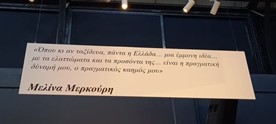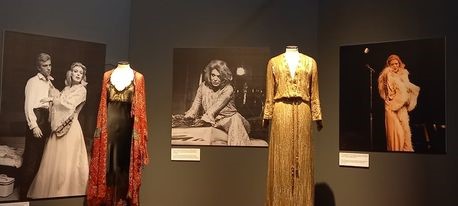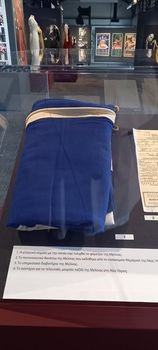Melina, the last Greek goddess
Melina Mercouri was an icon of her era. She was a woman of action, a woman of passion, and an influential figure in the fields of arts and politics.

When I first visited with my 11-years-old son the exhibition on Melina Mercouri ‘Remember me and love me’ (named after the song composed by Stavros Xarchakos for the film ‘Melina Mercouri’s Greece’, 1965) at the Technopolis of the Municipality of Athens (18th January – 11th March 2022), I had the strong feeling that Melina was staring at us… Her beautiful eyes on the 25 film posters and the 37 photos from her theatrical performances and with famous personalities filled the exhibition hall. But it was not just her eyes; her voice too, singing with Manos Chatzidakis and Mikis Theodorakis (a recent loss), performing in theatre and acting in cinema, or speaking passionately against the Junta and for freedom and democracy, overwhelmed the place through two big video screens. All these photos and sounds recalled my own childhood – with a bit of nostalgia, alas- in the ‘80s, when Melina was an active Minister of Culture.
 |
 |
Melina was certainly present in this exhibition in more than one way. Beautifully designed by Nikos Kaltsas (the new Director of the Cycladic Museum, and former Director of the National Archaeological Museum), with the co-operation of Manuella Pavlidou (on behalf of the Melina Mercouri Foundation), this exhibition, organized by the Ministry of Culture and Sports, in the heart of the historical centre of Athens marked the centenary since Melina’s birth (1920) and a celebration for Melina’s (she is Melina par excellence for us) legacy to Greek culture. The exhibition is presented in two main parts: arts and politics, interwoven with each other since Melina expressed her passion in both arts and politics. Thirteen costumes of her films and plays recall her international success as an actress (Top Kapi; Phaedra; The Streetcar named Desire; Sweet Bird of Youth etc.). As the Minister of Greek Culture (1981-1989, 1993-1994) she related her name with the campaign for the return and reunification of the Parthenon Marbles (the so-called 'Elgin Marbles’ until then). She was also responsible for the foundation of many Municipal and Regional Theatres (DI.PE.THE), the institution of the Cultural Capital of Europe (Athens being the first in 1985), the restoration project of the Acropolis monuments, the unification of the archaeological sites of Athens, and the introduction of school education in theatre and culture ‘so that a different society, a different mentality, and different politics are created’.
 |
 |
 |

Some of her personal objects are also exhibited, including parts of her dressing room, her passport, other official documents, and press excerpts reporting her death on 6th March 1994. My son was particularly touched by two specific exhibits: the folded Greek flag which covered her coffin and a copy of the red dress that she used to wear during her fiery anti-dictatorship speeches abroad which she had asked to be buried with. ‘Well, she chose to be remembered – and be buried- as a true Greek fighter, not as an actress!’ my son uttered. This reminded me of the Aeschylus’ funerary epigram[1].
Melina’s legacy to younger generations may be to fight for one’s principles, for the common good, for culture and humanism. Melina’s campaign for the return of the Parthenon Marbles to Athens is still an open issue, which should be taught at school, not just as a matter of political debate, but also as an example of cultural diplomacy and as training in the concepts of democracy, freedom, and cultural heritage. Melina’s dream is still alive worldwide and it deserves to come true at last, so that she is reborn too.
Antiopi Argyriou-Casmeridis
[1] The epigram of Aeschylus’ gravestone at Gela, cited by ancient sources, while unlikely to be by Aeschylus himself was probably written soon after his death by a member of his family: Αἰσχύλον Εὐφορίωνος, Ἀθηναῖον τόδε κεῦθει/ μνῆμα καταφθίμενον πυροφόροιο Γέλας// ἀλκήν δ ́εὐδόκιμον, Μαραθώνιον ἄλσος ἄνεἴποι/ καί βαθυχαιτήεις Μῆδος ἐπιστάμενος (="Beneath this stone lies Aeschylus, son of Euphorion, the Athenian, who died in the wheat-bearing land of Gela; of his noble prowess the grove of Marathon can speak, and the long-haired Persian knows it well"). Athenaeus 14.627c-d; Pausanias 1.14.5; Plutarch, Moralia 604e-f). The inscription on his gravestone commemorates his military achievements against the Persians at Marathon, but makes no mention of his enormous theatrical renown. See Krikona, E., “The Memory of the Persian Wars through the Eyes of Aeschylus: Commemorating the Victory of the Power of Democracy”, Akropolis: Journal of Hellenic Studies 2 (2018): 85-104.
 |
 |
|

The Melina Mercouri ‘Remember me and love me’ exhibition closed on 11th of March.
Antiopi Argyriou-Casmeridis has a Doctorate in Ancient History (PhD, Royal Holloway University of London) and is an alumna of the University of Cambridge (MPhil in Classics, Clare College), and a High School Teacher of Classics at Ralleio Girls' School of Piraeus.



Comments powered by CComment